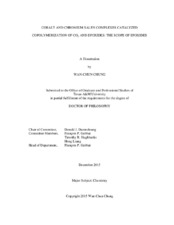| dc.description.abstract | The copolymerization of epoxide and carbon dioxide catalyzed by metal complexes provides an efficient method for synthesizing polycarbonates. Compared to industrial polycarbonate production, which involves toxic phosgene reagent, this is a cleaner and greener way which uses a renewable, abundant and non-toxic gas CO2, and has 100% atom economy. This dissertation focuses on the investigation of epoxide reactivities in the copolymerization with CO2 and the properties of the resulting polycarbonates.
First of all, the electronics of the epoxide monomers were studied. Herein, we determined the epoxide coordinating ability, or basicity, by infrared spectroscopy, based on the O-D vibration shifts of CH3OD in epoxides versus that observed in benzene. As expected, epoxides with electron-donating alkyl groups were found to be more basic compared to those with electron-withdrawing substituents. The relative basicities of epoxides were shown to greatly influence the interpretation of reactivity ratios of two epoxides in their terpolymerization with CO2. On the other hand, steric effects of epoxides were also studied by investigating copolymerization of CO2 with a series of butene oxides with methyl substituent groups in different positions. Among these butane oxides, only cis-2-butene oxide when coupled with CO2 was able to produce polycarbonate.
Copolymerizations of different cyclic epoxides with CO2 were discussed regarding their ring sizes and functionalities. Cyclopentene oxide was shown to have distinct reactivity and polymer selectivity over cyclic carbonate compared to widely studied cyclohexene oxide. Postpolymeization functionalization of the polycarbonate from cyclohexadiene oxide via the thiol-ene reaction was applied to provide totally water-soluble polycarbonate. Besides, the olefin positions in cyclohexadiene oxides affected their reactivities. That is, 1,3-cyclohexadiene oxide, which has the olefin group adjacent to epoxide group, was more active than the 1,4-isomer.
In the last part of this dissertation, the application of metal-organic frameworks (MOF) in CO2 sequestration was investigated. CO2 collected at atmospheric pressure over MOF was thermally released and utilized in copolymerization with propylene oxide to synthesize poly (propylene carbonate). Comparative studies using CO2 provided directly from a compressed gas source gave similar propylene oxide conversion and molecular weight. This study showed the feasibility of utilizing MOF for CO2 storage. | en |


